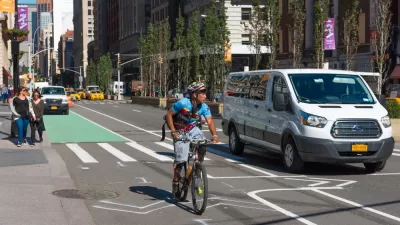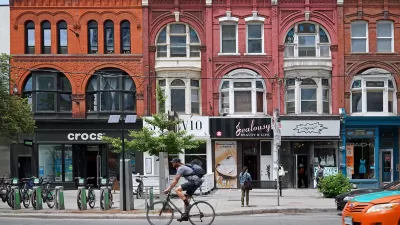The Regional Plan Association is calling on New York City to implement an ambitious plan to transform the city into a world class city for biking—for the benefit of the public health and economic realities of the pandemic and beyond.

The Regional Plan Association (RPA) released a plan for a Five Borough Bikeway this week, calling for a revolution in the management and use of streets in the city of New York.
"We need to develop a network of priority, high-capacity, protected bike lanes that serve as the heart of a comprehensive and cohesive bicycle network," according to the RPA.
The report commences from a discussion about the quiet of city streets during the stay-at-home orders of the pandemic and the emergence of the bicycle as a preferred method of transportation during the trouble early months of the crisis.
As work and travel restrictions are gradually lifted, NYC’s infrastructure will need to handle growing numbers of travelers in ways that ensure more space per person. There is also a wide consensus on the need for additional federal support for infrastructure spending to stimulate economic activity and development. One of the best ways to get NYC up and moving again quickly, and with peace of mind, would be through the proliferation of bike lanes that are laid out in this report.
The plan lays out a phased implementation plan, which would start with planters and bollards before laying the long-term cornerstones of a strategy to reduce greenhouse gas emissions in the city. The entire Five Borough Bikeway would span 425 miles of continuous, protected bike infrastructure.
The Five Borough Bikeway Plan is available in its entirety on the RPA's website.
FULL STORY: The Five Borough Bikeway

Alabama: Trump Terminates Settlements for Black Communities Harmed By Raw Sewage
Trump deemed the landmark civil rights agreement “illegal DEI and environmental justice policy.”

Planetizen Federal Action Tracker
A weekly monitor of how Trump’s orders and actions are impacting planners and planning in America.

The 120 Year Old Tiny Home Villages That Sheltered San Francisco’s Earthquake Refugees
More than a century ago, San Francisco mobilized to house thousands of residents displaced by the 1906 earthquake. Could their strategy offer a model for the present?

In Both Crashes and Crime, Public Transportation is Far Safer than Driving
Contrary to popular assumptions, public transportation has far lower crash and crime rates than automobile travel. For safer communities, improve and encourage transit travel.

Report: Zoning Reforms Should Complement Nashville’s Ambitious Transit Plan
Without reform, restrictive zoning codes will limit the impact of the city’s planned transit expansion and could exclude some of the residents who depend on transit the most.

Judge Orders Release of Frozen IRA, IIJA Funding
The decision is a victory for environmental groups who charged that freezing funds for critical infrastructure and disaster response programs caused “real and irreparable harm” to communities.
Urban Design for Planners 1: Software Tools
This six-course series explores essential urban design concepts using open source software and equips planners with the tools they need to participate fully in the urban design process.
Planning for Universal Design
Learn the tools for implementing Universal Design in planning regulations.
Clanton & Associates, Inc.
Jessamine County Fiscal Court
Institute for Housing and Urban Development Studies (IHS)
City of Grandview
Harvard GSD Executive Education
Toledo-Lucas County Plan Commissions
Salt Lake City
NYU Wagner Graduate School of Public Service





























